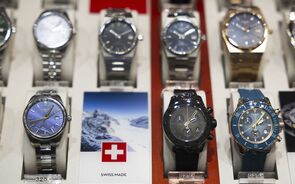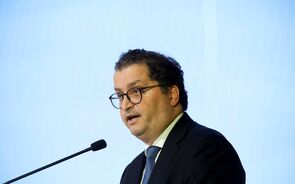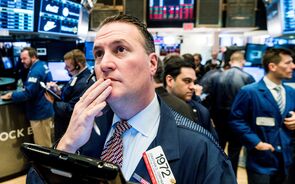13:30 - Dados States
1 Mensagem
|Página 1 de 1
13:30 - Dados States
8:30am 08/27/04 U.S. Q2 GDP REVISED TO 2.8% FROM 3.0% AS EXPECTED
8:30am 08/27/04 U.S. Q2 CONSUMER SPENDING REVISED TO 1.6% VS. 1.0 %
8:30am 08/27/04 U.S. Q2 FINAL SALES REVISED TO 2.1%
8:30am 08/27/04 U.S. Q2 PCE UNCHANGED AT 3.2%, CORE PCE AT 1.7%
8:30am 08/27/04 U.S. Q2 DISPOSABLE INCOME REVISED TO 2.5% FROM 2.9%
8:30am 08/27/04 U.S. Q2 BUSINESS INVESTMENT UP 12.1%
8:30am 08/27/04 U.S. Q2 AFTER-TAX CORPORATE PROFITS UP 17.9% Y-O-Y
8:30am 08/27/04 DOWNWARD REVISON TO U.S. GDP DUE TO LARGE TRADE GAP
ECONOMIC REPORT: U.S. Q2 GDP revised to 2.8% as expected
By Rex Nutting, CBS.MarketWatch.com
Last Update: 8:30 AM ET Aug. 27, 2004
WASHINGTON (CBS.MW) - The U.S. economy slowed in the second quarter of the year, growing at a 2.8 percent annual rate after a growth spurt in the previous four quarters, the Commerce Department reported Friday.
The government revised its earlier estimate of 3 percent annual growth in real gross domestic product to reflect more complete data on the economy's performance from April through June.
Economists were expecting a revision to about 2.8 percent, according to a survey conducted by CBS MarketWatch.
Economists are expecting growth to reaccelerate to about 3.5 percent to 4 percent in the current quarter, which ends Sept. 30, although some are beginning to question whether the June soft patch in growth will linger.
The big picture view of the economy was largely unchanged by the revisions. The trade deficit was a larger drag on growth than previously assumed, but consumer spending, business investment and inventory building were all stronger. Income growth was revised lower.
In current dollar terms, the GDP totaled $11.64 trillion annualized. GDP is the sum of all final sales of goods and services produced in the United States.
The economy has grown 4.7 percent in the past four quarters.
As in the earlier estimate, the new report showed consumer spending slowed in the quarter while investments surged. Final sales of domestic product increased 2.1 percent, the slowest in six quarters.
There were no changes to key inflation gauges, which showed higher energy and food costs put upward pressure on prices, while core inflation rates remained under control. The core personal consumption expenditure price index rose at a 1.7 percent annual rate.
The government also released its first estimates of second-quarter corporate profits, indicating a dramatic slowing in the most recent period.
Before-tax profits increased $1.6 billion from the first quarter compared with a $36.5 billion increase from the fourth quarter to the first. After-tax profits are up 17.9 percent year-over-year, down from 32.1 percent in the first quarter.
First-quarter personal income growth was revised lower in the release. Instead of growing $73.6 billion, wages and salaries increased $51.8 billion. Real disposable income increased 2.4 percent in the first quarter and 2.5 percent in the second quarter.
In the second quarter, consumer spending increased at a 1.6 percent annualized rate, up from the previous estimate of 1 percent, but down from 4.1 percent in the first quarter. Spending on durables declined 0.1 percent, including a 6.2 percent drop in spending on motor vehicles.
It was the slowest growth in consumer spending since the beginning of the recession three years ago.
Business investment surged in the quarter, rising 12.1 percent annualized, including a 13.6 percent increase in equipment and software and a 7.1 percent rise in structures. Investments in residences increased at a 14.7 percent annual rate.
The change in inventories increased $57.7 billion, adding about 0.7 percentage points to GDP.
Government spending increased at a 2.4 percent annual rate. Federal spending increased 2.7 percent, including 1.9 percent for defense and 4.5 percent for nondefense. State and local government spending increased 2.2 percent.
Exports increased 6.1 percent, the slowest growth in a year, while exports grew 14.1 percent. The trade gap subtracted 1.4 percentage points from GDP.
8:30am 08/27/04 U.S. Q2 CONSUMER SPENDING REVISED TO 1.6% VS. 1.0 %
8:30am 08/27/04 U.S. Q2 FINAL SALES REVISED TO 2.1%
8:30am 08/27/04 U.S. Q2 PCE UNCHANGED AT 3.2%, CORE PCE AT 1.7%
8:30am 08/27/04 U.S. Q2 DISPOSABLE INCOME REVISED TO 2.5% FROM 2.9%
8:30am 08/27/04 U.S. Q2 BUSINESS INVESTMENT UP 12.1%
8:30am 08/27/04 U.S. Q2 AFTER-TAX CORPORATE PROFITS UP 17.9% Y-O-Y
8:30am 08/27/04 DOWNWARD REVISON TO U.S. GDP DUE TO LARGE TRADE GAP
ECONOMIC REPORT: U.S. Q2 GDP revised to 2.8% as expected
By Rex Nutting, CBS.MarketWatch.com
Last Update: 8:30 AM ET Aug. 27, 2004
WASHINGTON (CBS.MW) - The U.S. economy slowed in the second quarter of the year, growing at a 2.8 percent annual rate after a growth spurt in the previous four quarters, the Commerce Department reported Friday.
The government revised its earlier estimate of 3 percent annual growth in real gross domestic product to reflect more complete data on the economy's performance from April through June.
Economists were expecting a revision to about 2.8 percent, according to a survey conducted by CBS MarketWatch.
Economists are expecting growth to reaccelerate to about 3.5 percent to 4 percent in the current quarter, which ends Sept. 30, although some are beginning to question whether the June soft patch in growth will linger.
The big picture view of the economy was largely unchanged by the revisions. The trade deficit was a larger drag on growth than previously assumed, but consumer spending, business investment and inventory building were all stronger. Income growth was revised lower.
In current dollar terms, the GDP totaled $11.64 trillion annualized. GDP is the sum of all final sales of goods and services produced in the United States.
The economy has grown 4.7 percent in the past four quarters.
As in the earlier estimate, the new report showed consumer spending slowed in the quarter while investments surged. Final sales of domestic product increased 2.1 percent, the slowest in six quarters.
There were no changes to key inflation gauges, which showed higher energy and food costs put upward pressure on prices, while core inflation rates remained under control. The core personal consumption expenditure price index rose at a 1.7 percent annual rate.
The government also released its first estimates of second-quarter corporate profits, indicating a dramatic slowing in the most recent period.
Before-tax profits increased $1.6 billion from the first quarter compared with a $36.5 billion increase from the fourth quarter to the first. After-tax profits are up 17.9 percent year-over-year, down from 32.1 percent in the first quarter.
First-quarter personal income growth was revised lower in the release. Instead of growing $73.6 billion, wages and salaries increased $51.8 billion. Real disposable income increased 2.4 percent in the first quarter and 2.5 percent in the second quarter.
In the second quarter, consumer spending increased at a 1.6 percent annualized rate, up from the previous estimate of 1 percent, but down from 4.1 percent in the first quarter. Spending on durables declined 0.1 percent, including a 6.2 percent drop in spending on motor vehicles.
It was the slowest growth in consumer spending since the beginning of the recession three years ago.
Business investment surged in the quarter, rising 12.1 percent annualized, including a 13.6 percent increase in equipment and software and a 7.1 percent rise in structures. Investments in residences increased at a 14.7 percent annual rate.
The change in inventories increased $57.7 billion, adding about 0.7 percentage points to GDP.
Government spending increased at a 2.4 percent annual rate. Federal spending increased 2.7 percent, including 1.9 percent for defense and 4.5 percent for nondefense. State and local government spending increased 2.2 percent.
Exports increased 6.1 percent, the slowest growth in a year, while exports grew 14.1 percent. The trade gap subtracted 1.4 percentage points from GDP.
-
Info.
1 Mensagem
|Página 1 de 1
Quem está ligado:
Utilizadores a ver este Fórum: nicoo e 46 visitantes


